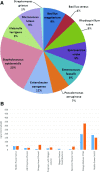Genomic Methods and Microbiological Technologies for Profiling Novel and Extreme Environments for the Extreme Microbiome Project (XMP)
- PMID: 28337070
- PMCID: PMC5345951
- DOI: 10.7171/jbt.17-2801-004
Genomic Methods and Microbiological Technologies for Profiling Novel and Extreme Environments for the Extreme Microbiome Project (XMP)
Erratum in
-
[No title available]J Biomol Tech. 2017 Jul;28(2):93. doi: 10.7171/jbt.17-2801-004CX. Epub 2017 Jun 8. J Biomol Tech. 2017. PMID: 28630597 Free PMC article.
Abstract
The Extreme Microbiome Project (XMP) is a project launched by the Association of Biomolecular Resource Facilities Metagenomics Research Group (ABRF MGRG) that focuses on whole genome shotgun sequencing of extreme and unique environments using a wide variety of biomolecular techniques. The goals are multifaceted, including development and refinement of new techniques for the following: 1) the detection and characterization of novel microbes, 2) the evaluation of nucleic acid techniques for extremophilic samples, and 3) the identification and implementation of the appropriate bioinformatics pipelines. Here, we highlight the different ongoing projects that we have been working on, as well as details on the various methods we use to characterize the microbiome and metagenome of these complex samples. In particular, we present data of a novel multienzyme extraction protocol that we developed, called Polyzyme or MetaPolyZyme. Presently, the XMP is characterizing sample sites around the world with the intent of discovering new species, genes, and gene clusters. Once a project site is complete, the resulting data will be publically available. Sites include Lake Hillier in Western Australia, the "Door to Hell" crater in Turkmenistan, deep ocean brine lakes of the Gulf of Mexico, deep ocean sediments from Greenland, permafrost tunnels in Alaska, ancient microbial biofilms from Antarctica, Blue Lagoon Iceland, Ethiopian toxic hot springs, and the acidic hypersaline ponds in Western Australia.
Keywords: Polyzyme; extremophile; metagenomics; shotgun sequencing; whole genome.
Figures






References
Publication types
MeSH terms
Substances
Grants and funding
LinkOut - more resources
Full Text Sources
Other Literature Sources
Molecular Biology Databases
